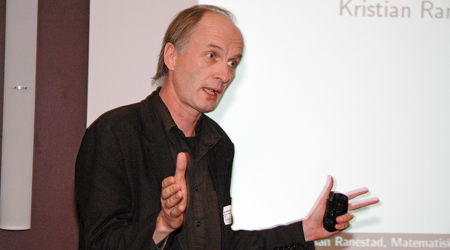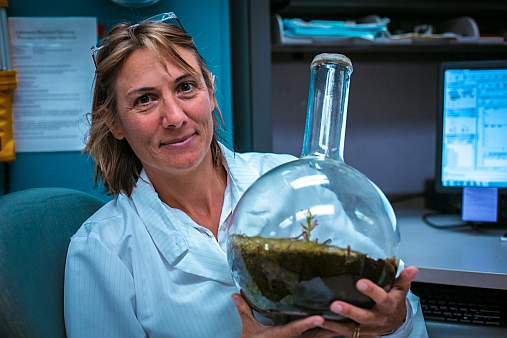Previous events - Page 224
The Faculty of Mathematics and Natural Sciences invites PhD candidates who started in 2016 to a day of motivation and inspiration on the 5th of September 2016.
Wang et al. MolecularEcology(2016)25,3605–3621
By Robert M. Pringle from Princeton University
Open for all! Speakers: Corina E. Tarnita from Princeton University and Jan M. Nordbotten from Department of Mathematics, University of Bergen. This event is part of the University’s annual celebration.
A class of nonlinear evolution equations of second order
Kristian Ranestad (UiO), gives the Seminar in Algebra and Algebraic Geometry:
"Kummer surfaces and hyperkähler fourfolds, as degeneracy loci"
Population matrix models have come a long way and perturbation analyses developed for them are among the most powerful tools of population ecologists. Most population projections are unthinkable without sensitivity analyses and LTREs (Life Table Response Experiments). Population projections are also most needed when climates are changing and habitats are altered, and that is when classic perturbation analyses for equilibrium systems fail.
In a recent paper, Koons et al. explore how to do LTREs in a transient world:
The Wilson Lecture speaker in 2016 will be Hope Jahren, Wilson Professor at CEED. The lecture will present the 30 most dramatic ways in which our planet has changed since the 1980’s — the numbers may surprise you. The lecture is in English and is open to all interested.
Andi Hektor, NICPB Tallinn
I will give a short introduction to Dark Matter physics. I will sum up the the main evidences of Dark Matter from the Galactic to large cosmological scales. So far the evidences are only gravitational. I will point out that even the gravitational signals of Dark Matter can hint about the deeper nature of Dark Matter, especially having soon new data from the Gaia and other soon starting experiments. Beyond gravitation, we have many experimental constraints on the ‘particle’ nature of Dark Matter and only few questionable hints of Dark Matter. Those experiments involve the accelerator (LHC at CERN), underground (‘direct detection') and cosmic experiments (‘indirect detection’). Due to rapidly evolving experimental and observational bounds the mainstream candidate of Dark Matter, Weakly Interacting Massive Particle, is losing its ground. I will point out some interesting escape scenarios of WIMP. I will conclude highlighting some interesting alternatives for WIMPy Dark Matter.
(Slides will be available here)
Gunnar Dick, Coordinator at the Centre for Digital Life Norway, will give an update on research and innovation opportunities within life sciences and biotechnology. Open for all: Postdocs/researchers are especially encouraged to participate.
Arturo Kohatsu-Higa (Ritsumeikan University, Kusatsu, Japan) gives a lecture with the title: Probabilistic interpretation of the parametrix method
This journal club we will be discussing conflicting studies on two virulence factors that are important for the Yersinia genus, invasin and YadA.
Upcoming seminar in meteorology and oceanography:
Speaker: Dr. Patrick Büker, Stockholm Environmental Institute (SEI), York University, UK
The upcoming Friday Mingle will be special. The MSc graduates of summer 2016 will receive their diplomas. The newly enrolled MSc students will also be there. And there will of course be room for chat and eating of cake.
After the Friday Mingle - at 12.00 - there will also be a BBQ in the garden.
Hope all of you are able to attend.
The journal club is back from summer vacations and we`ll dive into species diversification with the latest paper from Lewitus & Morlon (2016): "Natural constraints to species diversification". Join us!
Characterizing a Molecular Pathway Through Which Ikaros Functions as a Tumor Suppressor in BCR-ABL1+ pre-B Acute Lymphoblastic Leukemia (pre-B ALL)
Prof. Yasunori Fujikoshi (Hiroshima University) will give a seminar in Sverdrups plass (lunch area), 8th floor, Niels Henrik Abels hus at 14:15.
Habiba Ismail Mtongori at the Department of Geosciences will be defending her dissertation: Climate change and the impacts on crop-agriculture in Tanzania
The Logic Seminar will take place at the same time and location as in previous terms.
Doctoral candidate Habiba Ismail Mtongori at the Department of Geosciences will give a trial lecture on the given topic: El Niño, climate change and global food production
”Partial migration of birds in a changing climate”
”The Effects of Di-n-Butyl Phthalate (DBP) on Human Primary Immune Cells”
Welcome to the GeoHyd Lunch Seminar on Friday August 19th @ 12:15 in aud. 2 in the Geology building.
Andrea Cremaschi (earlier University of Kent, now UiO) will give a seminar in the lunch area, 8th floor Niels Henrik Abels hus at 14:15.
Bloch constructed higher cycle class maps from higher Chow groups to Deligne cohomology and étale cohomology. I will define a map from the motivic Eilenberg-Mac Lane spectrum to the spectrum representing Deligne cohomology in the motivic stable homotopy category over C such that it gives Bloch's higher cycle class map on cohomology. The map is induced by the map from Voevodsky's algebraic cobordism spectrum MGL to the Hodge-filtered complex cobordism spectrum defined by Hopkins-Quick. This extends a result of Totaro showing that the usual cycle class map to singular cohomology factors through complex cobordism modulo the coefficients of the Lazard ring MU^{2*} tensor_L Z. This is joint work with Amit Hogadi.



